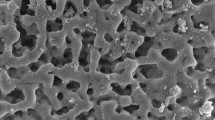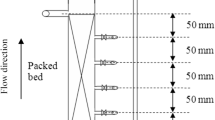Abstract
Bagasse fly ash (BFA, a sugar industrial waste) was used as low-cost adsorbent for the uptake of arsenate and arsenite species from water. The optimum conditions for the removal of both species of arsenic were as follows: pH 7.0, concentration 50.0 μg/L, contact time 50.0 min, adsorbent dose 3.0 g/L, and temperature 20.0 °C, with 95.0 and 89.5 % removal of arsenate and arsenite, respectively. The Langmuir, Freundlich, Temkin, and Dubinin–Radushkevich adsorption isotherms were used to analyze the results. The results of these models indicated single-layer uniform adsorption on heterogeneous surface. Thermodynamic parameters, i.e., ΔG°, ΔH°, and ΔS°, were also calculated. At 20.0 to 30.0 °C, the values of ΔG° lie in the range of −4,722.75 to −4,878.82 and −4,308.80 to −4,451.73 while the values of ΔH° and ΔS° were −149.90 and −121.07, and 15.61 and 14.29 for arsenate and arsenite, respectively, indicating that adsorption is spontaneous and exothermic. Pseudo-first-order kinetics was followed. In column experiments, the adsorption decreased as the flow rate increased with the maximum removal of 98.9 and 95.6 % for arsenate and arsenite, respectively. The bed depth service time and Yoon and Nelson models were used to analyze the experimental data. The adsorption capacity (N o) of BFA on column was 3.65 and 2.98 mg/cm3 for arsenate and arsenite, respectively. The developed system for the removal of arsenate and arsenite species is economic, rapid, and capable of working under natural conditions. It may be used for the removal of arsenic species from any contaminated water resources.






Similar content being viewed by others
References
Ali I, Asim M, Khan TA (2013) Arsenite removal from water by electro-coagulation on zinc–zinc and copper–copper electrodes. Int J Environ Sci Technol 10:377–384
Ali I, Gupta VK, Khan TA, Asim M (2012a) Removal of arsenate from aqueous solution by electro-coagulation method using Al-Fe electrodes. Int J Electrochem Sci 7:1898–1907
Ali I, Khan TA, Asim M (2011) Removal of arsenic from water by electrocoagulation and electrodialysis techniques. Sep Purif Rev 40:25–42
Ali I, Khan TA, Asim M (2012b) Removal of arsenate from groundwater by electrocoagulation method. Environ Sci Pollut Res 19:1668–1676
Ali I, Rahman A, Khan TA, Alam SD, Khan J (2012c) Recent trends of arsenic contamination in groundwater of Ballia District, Uttar Pradesh, India. GU J Sci 25(4):853–861
Andrew AS, Mason RA, Kelsey KT, Schned AR, Marsit CJ, Nelson HH, Karagas MR (2009) DNA repair genotype interacts with arsenic exposure to increase bladder cancer risk. Toxicol Lett 187:10–14
Banerjee K, Amy GL, Prevost M, Nour S, Jekel M, Gallagher PM, Blumenschein CD (2008) Kinetic and thermodynamic aspects of adsorption of arsenic onto granular ferric hydroxide (GFH). Water Res 42:3371–3378
Bao L, Shi H (2010) Potential molecular mechanisms for combined toxicity of arsenic and alcohol. J Inorg Biochem 104:1229–1233
Bilici BM, Pala AA (2010) Statistical experiment design approach for arsenic removal by coagulation process using aluminum sulfate. Desalination 254:42–48
Bohart CS, Adams EQ (1920) Some aspects of the behavior of charcoal with respect to chlorine. J Am Chem Soc 42:523–544
Brammer H, Ravenscroft P (2009) Arsenic in groundwater: a threat to sustainable agriculture in South and South-East Asia. Environ Int 35:647–654
Dabrowski A (2001) Adsorption-from theory to practice. Adv Colloid Interface Sci 93:135–224
Floch J, Hideg M (2004) Application of ZW-1000 membranes for arsenic removal from water sources. Desalination 162:75–83
Freundlich H (1906) Adsorption in solids. Z Phys Chem 57:385–470
Gibb H, Haver C, Gaylor D, Ramasamy S, Lee JS, Lobdell D, Wade T, Chen C, White P, Sams R (2011) Utility of recent studies to assess the National Research Council 2001 estimates of cancer risk from ingested arsenic. Environ Health Perspect 119:284–290
Gunay A, Arslankaya E, Tosun I (2007) Lead removal from aqueous solution by natural and pretreated clinoptilolite: adsorption equilibrium and kinetics. J Hazard Mater 146:362–371
Hall KR, Eagleton LC, Acrivos A, Vermeulen T (1966) Pore and solid-diffusion kinetics in fixed-bed adsorption under constant pattern conditions. Ind Eng Chem Fundtl 5:212–223
Hameed BH (2009) Removal of cationic dye from aqueous solution using jackfruit peel as non-conventional low-cost adsorbent. J Hazard Mate 162:344–350
Hobson JP (1969) Physical adsorption isotherms extending from ultra-high vacuum to vapor pressure. J Phys Chem 73:2720–2727
Hong H, Yang J, Kim B, Yang J (2011) Arsenic removal behavior by Fe-Al binary oxide: thermodynamic and kinetic study. Sep Sci Technol 46:2531–2538
Hutchins RA (1973) Designing activated carbon systems. Chem Eng 80:133–138
Jain CK, Ali I (2000) Arsenic: occurrence, toxicity and speciation techniques. Water Res 34:4304–4312
Jay JA, Keon BN, Hemond HF, Durant JL (2004) Arsenic-sulfides confound anion exchange resin speciation of aqueous arsenic. Water Res 38:1155–1158
Jimenez-Cedillo MJ, Olguin MT, Fall CH, Colin A (2011) Adsorption capacity of iron or iron-manganese-modified zeolite-rich tuffs for As(III) and As(V) water pollutants. Appl Clay Sci 54:206–216
Kim J, Benjamin MM (2004) Modeling a novel ion exchange process for arsenic and nitrate removal. Water Res 38:2053–2062
Kim YH, Kim CM, Choi IH, Rengaraj S, Yi JH (2004) Arsenic removal using mesoporous alumina prepared via a templating method. Environ Sci Technol 38:924–931
Lagergren S (1898) Kungliga Svenska. Vetenskapsakad Handl 24:1
Langmuir I (1918) The adsorption of gases on plane surfaces of glass, mica and platinum. J Am Chem Soc 40:1361–1402
Luther S, Borgfeld N, Kim J, Parsons JG (2012) Removal of arsenic from aqueous solution: a study of the effects of pH and interfering ions using iron oxide nanomaterials. Microchemical J 101:30–36
McNeill LS, Edwards M (1995) Soluble arsenic removal at water treatment plants. J Am Water Works Assoc 87:105–113
Muniz G, Fierro V, Celzard A, Furdin G, Gonzalez-Sanchez G, Ballinas ML (2009) Synthesis, characterization and performance in arsenic removal of iron doped activated carbons prepared by impregnation with Fe(III) and Fe(II). J Hazard Mater 165:893–902
Nguyen TV, Rahman A, Vigneswaran S, Ngo HH, Kandasamy J, Nguyen DT, Do TA, Nguyen TK (2009) Arsenic removal by iron oxide coated sponge: treatment and waste management. Water Sci Technol 60:1489–1495
Oehmen A, Valerio R, Llanos J, Fradinho J, Serra S, Reis MAM, Crespo JG, Velizarov S (2012) Arsenic removal from drinking water through a hybrid ion exchange membrane—coagulation process. Sep Purif Technol 83:137–143
Pearce DC, Dowling K, Sim MR (2012) Cancer incidence and soil arsenic exposure in a historical gold mining area in Victoria, Australia: a geospatial analysis. J Expo Sci Environ Epidemiol 22:248–257
Qu D, Wang J, Hou D, Luan Z, Fan B, Zhao C (2009) Experimental study of arsenic removal by direct contact membrane distillation. J Hazard Mater 163:874–879
Rajakovic LV (1992) The sorption of arsenic onto activated carbon impregnated with metallic silver and copper. Sep Sci Technol 27:1423–1433
Schaumloeffel D, Neidhart BA (1996) FIA-system for As(III)/As(V) determination with electrochemical hydride generation and AAS detection. Fresenius J Anal Chem 354:866–869
Shah BA, Mistry CB, Shah AV (2013a) Sequestration of Cu(II) and Ni(II) from wastewater by synthesized zeolitic materials: equilibrium, kinetics and column dynamics. Chem Eng J 220:172–184
Shah BA, Shah AV, Jadav PY (2013b) Extractive efficacy for acephate of microwave synthesized zeolitic materials: equilibrium and kinetics. J Serb Chem Soc 78(7):1055–1077
Shah BA, Shah AV, Tailor RV (2012) Sorptive removal of by zeolitic bagasse fly ash: equilibrium, kinetics, column studies. Chem Eng Data 57:1437–1448
Sivaraj R, Namasivayam C, Kadirvelu K (2000) Orange peel as an adsorbent in the removal of Acid Violet 17 (acid dye) from aqueous solutions. Waste Manage 21:105–110
Tan TC, Chia CK, Teo CK (1985) Uptake of metal ions by chemically treated human hair. Water Res 19:157–162
Temkin MI, Pyzhev V (1940) Kinetics of ammonia synthesis on promoted iron catalysts. Acta Physicochim 12:327–356
Tsai WT, Chang CY, Ho CY, Chen LY (1999) Adsorption properties and breakthrough model of 1,1-dichloro-1-fluoroethane on activated carbons. J Hazard Mater 69:53–66
Van HK, Verhaege M, Verstraete W (2004) Electro-oxidative abatement of low-salinity reverse osmosis membrane concentrates. Water Res 38:1550–1558
Vogel AI, Jeffery GH (1989) Vogel’s textbook of quantitative chemical analysis. Longman Scientific & Technical. Wiley
Yoon YH, Nelson JH (1984) Application of gas adsorption kinetics. I. A theoretical model for respirator cartridge service life. Am Ind Hyg Assoc J 45:509–516
Zhang S, Niu H, Cai Y, Zhao X, Shi Y (2010) Arsenite and arsenate adsorption on co-precipitated bimetal oxide magnetic nanomaterials: MnFe2O4 and CoFe2O4. Chem Eng J 158:599–607
Acknowledgments
The authors are thankful to the University Grant Commission (UGC), New Delhi, India for providing BSR Fellowship to Mohd Asim and King Saud University for funding Visiting Professorship Programme.
Author information
Authors and Affiliations
Corresponding author
Additional information
Responsible editor: Philippe Garrigues
Rights and permissions
About this article
Cite this article
Ali, I., Al-Othman, Z.A., Alwarthan, A. et al. Removal of arsenic species from water by batch and column operations on bagasse fly ash. Environ Sci Pollut Res 21, 3218–3229 (2014). https://doi.org/10.1007/s11356-013-2235-3
Received:
Accepted:
Published:
Issue Date:
DOI: https://doi.org/10.1007/s11356-013-2235-3




